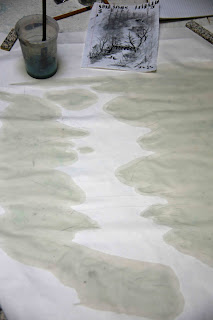I've been asked quite frequently as to how to paint mountain lobes.
As I explained in the "Ridge Top Explained" blog, we treat them like slices of the whole mountain range. Since mountains come in different shapes, we can paint them into any forms our imagination leads us.
The problem I see is not with the shape, or contour of our paintings, but rather with the interpretation of the light values.

contour lines depicted.
My advice is to look at our fingers for illustration. Each finger represents a lobe or a slice of the mountain. The outline of each finger is defined by the contour line. We can see in this picture, the darkest part of the "lobe" is immediately on top of the contour line from the finger below. The brightest part is right under the lobe's own contour line. These light values help to define perspective and contribute to the three dimensional feel of the object. There is no line separating the sliver of bright area from the dark area.
We do want to paint in the contour line ( in most cases ) to define the lobe ( or finger in this case ) but we do not want any lines in between the dark and bright. The light value line is a concept, not an actual line. This is the reason that "chuen" marks are preferred in the shaded areas of the lobe, and that the bottom edges of the "chuen" strokes should meet the contour line from below, thus avoid leaving misplaced "bright" areas.
A misplaced line can wreak havoc with our perception of the landscape. We must not confuse the contour line with the imaginary light value line.

ribbon "chuen"

hemp "chuen"
Even complicated landscape masses like the 2 inserts above can be dealt with step by step, as long as one recognizes where the contour lines are, and do not paint a line to denote light values. Strategically placed shading brings out the 3 dimensional feel. Pay attention to these nuggets of information next time we look at rock formations. Garnish the details, but address the entire mass to evoke that "feel".
When in doubt, look at our own fingers.






























